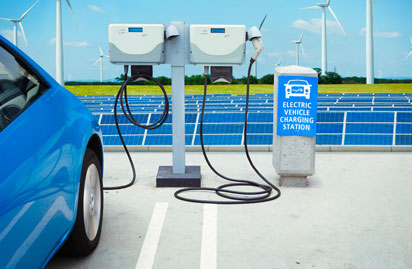India's Prime Minister, Narendra Modi, had pledged at the United Nations Climate Change Conference (COP26) in Glasgow, in November 2021, that India would attain net-zero carbon emissions by 2070. Net-zero emission is achieved when all man-made greenhouse gas emissions are eliminated from the atmosphere through reduction methods that stabilise global temperatures. This article will look at how India plans to achieve this target, the progress made so far and future projections.
India's total greenhouse gas (GHG) emissions have been around 2,442 million tonnes of CO2 equivalent (MtCO2e), making it the world's third-largest emitter after China (10,668 MtCO2e) and the United States (4,713 MtCO2e). While India's total emissions are nothing close to China and the US, it contributes only 5 per cent of the global emissions, yet the country’s emissions have consistently climbed over the previous decade. The modest decline in 2020 could be attributed to the pandemic and a prolonged economic recession.
Prime Minister Modi has announced a few commitments, or ‘Amrit Tatva’, to achieve the target of net-zero emissions by 2070:
- India's non-fossil capacity to reach 500 gigawatts by 2030.
- India will meet 50 per cent of its energy needs with renewable energy by 2030.
- Between now and 2030, India will eliminate one billion tonnes of total estimated carbon emissions.
- By 2030, India's economy will have a carbon intensity of less than 45 per cent.
- He has also urged everyone to make environmentally conscious lifestyle choices.
Actions to be taken and projections
Industry experts suggest that India will need around $10 trillion (INR 700 lakh crore) to achieve net-zero emissions by 2070; financial regulators such as the Reserve Bank of India and the Securities and Exchange Board of India (SEBI) must provide an enabling ecosystem for funding India's transition to a green economy; that domestic and international institutions should account for the majority of investments; and public funds should act as a catalyst by de-risking existing and emerging clean technology initiatives.
India has also encouraged the developed world to mobilise $100 billion yearly, for a five-year period from 2021 to 2025, towards climate financing help for developing nations to satisfy their existing carbon emission responsibilities.
Industry experts also predict that for net zero emissions by 2070, India's total installed solar power capacity will need to expand to 5,630 gigawatts. However, coal use, particularly for power generation, would peak by 2040 and then decline by 99 per cent between 2040 and 2060; crude oil use in all sectors would peak by 2050 and then drop by 90 per cent between 2050 and 2070; green hydrogen may meet 19 per cent of the industrial sector's total energy requirements.
Nationally Determined Contributions (NDCs)
Additionally, NDCs are meant to mitigate the carbon emissions. These represent each country's commitments, at a national level, to address climate change, with especial reference to priorities, capacities and action to be taken. Examples of a few NDCs identified by India are:
- Reduce the intensity of Gross Domestic Product (GDP) emissions by 33-35 per cent, by 2030 as compared to 2005.
- By 2030, non-fossil fuels will account for 40 per cent of installed electric generating capacity.
- By 2030, generate a new carbon sink of 2.5-3 billion tonnes of CO2 equivalent.
Conclusion
India was well on its track to fulfilling its NDCs by 2020. India's 3rd Biennial Update to the United Nations Framework Convention on Climate Change (UNFCCC) says, between 2005 and 2016, it cut its GDP emissions intensity by 24 per cent. The country's per capita emissions are relatively low, at 1.94 tonnes of CO2 per person, less than half of the global average of 4.2 tonnes of CO2 per person. When massive hydropower projects and nuclear power are factored in, India's non-fossil fuels account for nearly as much as the country's NDC under the Paris Agreement. However, the country's forest and tree cover has only risen by 5,188 km2, resulting in a 42.6 million tonne (Mt) carbon sink increase compared to a commitment of 680-817 Mt.
Also, environmentalists are of the view that India’s NDCs need to be more ambitious. The country's 40 per cent non-fossil fuel electrical capacity objective has been rated as "critically insufficient" by the worldwide Climate Action Tracker (CAT). Also, the CAT has placed its emissions intensity target as "very insufficient". If the 2015 Paris Agreement's 1.5 degrees Celsius global warming goal is to be met, this review has a lot of room for improvement.
There have been voices that also highlight upon the need for the administration to rethink several recent policy decisions so as to quicken the pace of progress, as well as to be more specific about the targets and identify the goals more specifically to meet the target. E.g.: Consider the twin goals of reaching 500 GW of non-fossil energy capacity and meeting 50% of total energy demand with renewables by 2030. India's installed renewable energy capacity was 98.8 GW in July 2021. Though this is a considerable improvement from the low of 39 GW in 2015, it falls short of the 175 GW target set by the Sustainable Development Goals (SDGs) for 2022. CAT predictions show, however, that India would most certainly reach its non-fossil fuel capacity objective. If the forecasts become correct, it will be due to low-cost solar and wind energy, the cheapest among India's electricity sources, increased investment in solar photovoltaics, incentive-driven manufacturing hubs for renewables, and a new legislative push toward biofuels.
However, more significant investment in fossil fuel extraction, mining infrastructure, and transportation has been juxtaposed to boost coal production to 1 billion tonnes by 2023-24. Since 2015, coal-fired electricity output has grown at a 6% yearly rate, with coal capacity predicted to climb from 202 GW in 2021 to 266 GW in 2030. This is demonstrated by the recent auctioning of 40 new coal mines. India's last-minute resistance to coal "phasing out" at COP26 reflects this resurgent drive for coal.






